
Thinking of climbing Mount Elbert? Mount Elbert is the highest 14er in Colorado, USA. At 14,440 feet (4,401 meters), it is the highest mountain in Colorado. It is also a relatively easy 14er, making it a popular climb for many. In this guide is everything you need to know about planning your climb on Mount Elbert.
- Where Is Mount Elbert?
- How Are The Views On Mount Elbert?
- When Is The Best Time To Climb Mount Elbert?
- What Are The Temperatures On Mount Elbert?
- How Long Does It Take To Climb Mount Elbert?
- How Many Trails Are There?
- How Do You Choose Which Trail To Take?
- What To Expect On The North Trail
- What To Expect On The South Trail
- What Time Should You Start Climbing (Itineraries)
- Do You Need A Permit? Are There Any Fees?
- What To Wear
- Packing List And What To Bring
- How To Get To The Trailhead?
- Locations Of Parking Lots
- Camping And Accomodation
- Climbing Mount Elbert In Winter: A Recap And Important Things to Note
- What Are The Dangers Of Climbing Mount Elbert?
- Other Important Information
Climbing a 14er is a big thing in Colorado. A 14er is a mountain that’s higher than 14,000 feet (4,267 meters). There are 53 14ers in Colorado.
Every year, there are about 20,000 to 25,000 people climbing Mount Elbert.
Here is some quick information about the climb at a glance:
| Elevation (feet) | 14,440 |
| Elevation (meters) | 4,401 |
| Popular Route | North Mount Elbert Trail South Mount Elbert Trail |
| YDS Class | Class 1 |
| Route Type | Loop |
| Climbing Season | All year |
| Best Time To Climb | Jun — Sep |
| Snow And/ Or Ice | Winter (some snow or ice may be seen at the summit even in the summer) |
| Permit Requirement | No |
This is Part 2 of 6 of the Mountains To Climb In The US Mini-series:
Part 1: Highest Mountains To Climb In The US For Beginners
Part 2: Ultimate Guide To Climbing Mount Elbert
Part 3: Ultimate Guide To Climbing Mount Katahdin
Part 4: Ultimate Guide To Climbing Mount Bierstadt
Part 5: Ultimate Guide To Climbing South Sister
Part 6: Ultimate Guide To Climbing Mount Borah
Where Is Mount Elbert?
Mount Elbert is located in the Leadville Ranger District of the San Isabel National Forest.
Here’s a map giving you a quick orientation of the area around Mount Elbert:
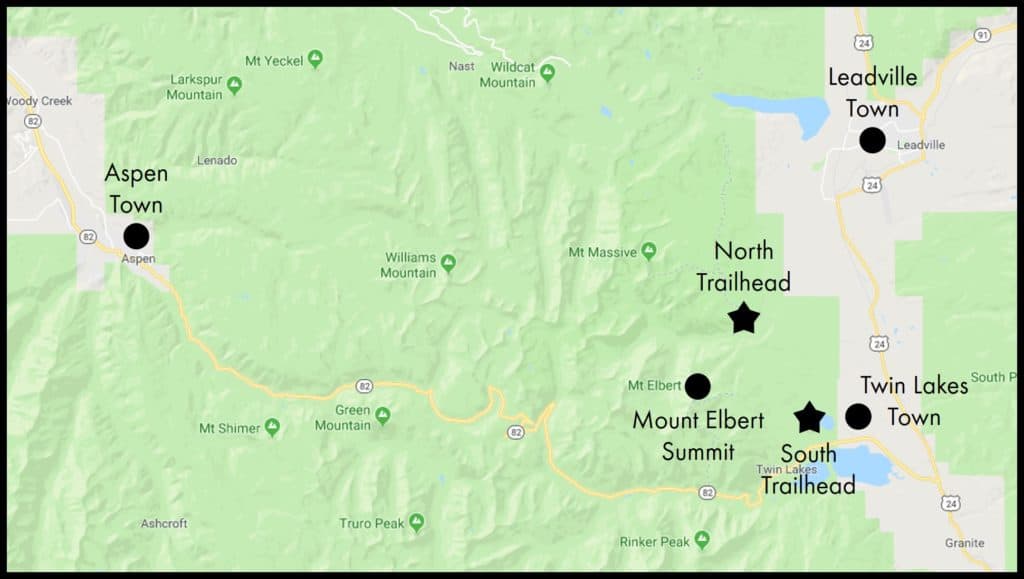
There are 3 nearby towns — Leadsville, Twin Lakes and Aspen. You can stock up on supplies and find restaurants and accommodation in these towns.
There are 2 popular routes for climbing Mount Elbert — the North Elbert Trail and South Elbert Trail.
If you would like to visit the visitor center or ranger’s office before your climb, they can be found in Leadsville.
Leadville Ranger District
Address: 810 Front St, Leadville, CO 80461, USA
Telephone: 719 486 0749
Fax: 719 486 0928
Leadville Visitor Center
Address: 809 Harrison Ave, Leadville, CO 80461, USA
Opening hours: Thu to Sat — 10 am to 4 pm, Sun — 11 am to 3 pm
Telephone: 855 488 1222
How Are The Views On Mount Elbert?
People are often looking for the best 14er to climb that offers the best views.
Being the highest mountain in the state, you can’t get a higher and better vantage point than this.
On the summit, you can see Mount Massive, the second highest peak in Colorado and 13er, Mount Oklahoma. In the distance, you can also catch a view of another 14er, Mount of the Holy Cross.
And being the highest mountain in Colorado, there’s no reason why you should miss out on climbing Mount Elbert!
When Is The Best Time To Climb Mount Elbert?
Mount Elbert can be climbed all year round.
The best time to climb Mount Elbert will be in July and August. This is also the peak season where you will see more climbers.
The weather varies from year to year. If the temperatures are warm enough, climbing in June or September may also be possible.
But even in the summer, do not expect fair weather. Afternoon thunderstorms are common from as early as 1 pm. It is recommended to start climbing very early in the morning to avoid getting caught in the rain.
From October to May, you will find more snow and ice in the mountains. You will have to be prepared for winter climbing if you plan to go during this period. Climbing Mount Elbert in winter is more suited for experienced climbers. There is more information on winter climbing in the section below.
Here’s a comparison of the amount of snow you will find on Mount Elbert during each month of the year:
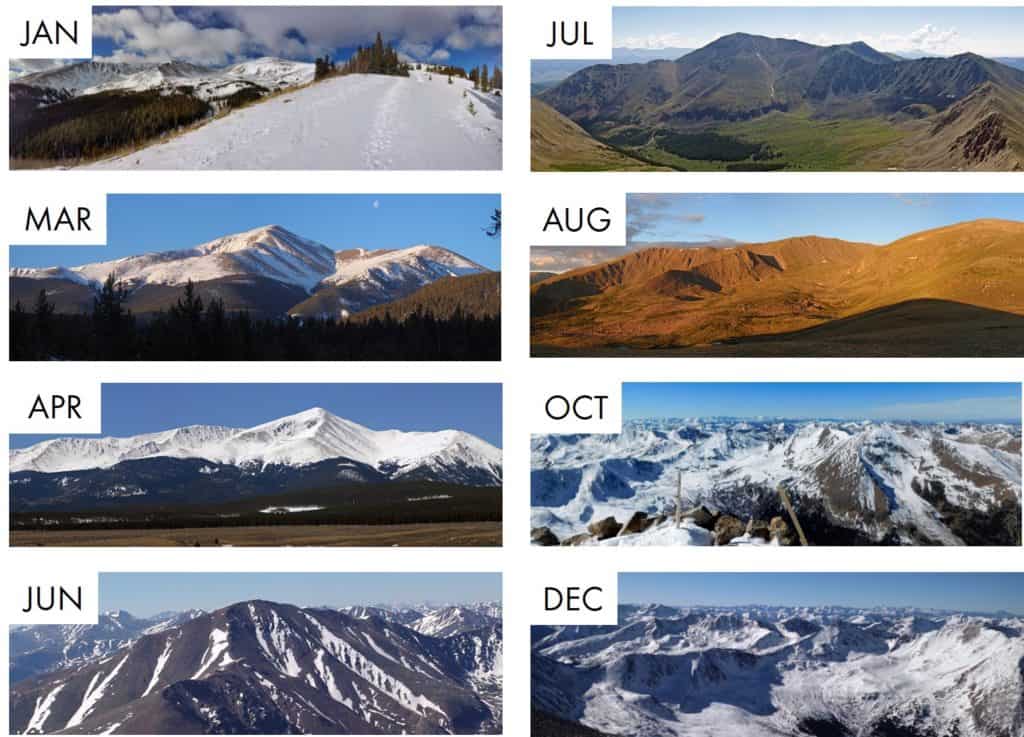
* The conditions and temperatures vary year to year. Make sure you check the latest forecast before your climb.
What Are The Temperatures On Mount Elbert?
These are the average monthly temperatures on Mount Elbert.
| Low/ High (Fahrenheit) | Low/ High (Celsius) | |
| January | -15 / 15 | -26 / -9 |
| February | -14 / 17 | -26 / -8 |
| March | -6 / 22 | -21 / -5 |
| April | 2 / 29 | -17 / -2 |
| May | 11 / 39 | -12 / 4 |
| June | 18 / 51 | -8 / 10 |
| July | 24 / 56 | -4 / 13 |
| August | 23/ 53 | -5 / 12 |
| September | 16 / 47 | -9 / 8 |
| October | 7 / 35 | -14 / 2 |
| November | -2 / 24 | -19 / -5 |
| December | -11 / 16 | -24 / -9 |
Do note that the temperature drops as you go higher up the mountain.
The elevation gain from the trailheads to the summit is about 4,000 to 5,000 feet (1,220 to 1,520 meters). You can expect a temperature drop of about 20 to 25 F (11 to 14 C) from the trailheads to summit.
Save to Pinterest and add this to your bucket list!
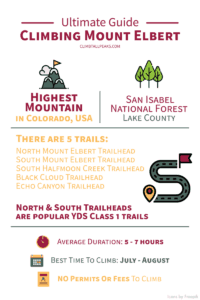
How Long Does It Take To Climb Mount Elbert?
In the summer, the average time for a round trip up and down Mount Elbert is about 5 to 7 hours using the North or South Mount Elbert Trails. Expect longer climbs in the winter.
I have seen reports of climbers completing it in 3 to 4 hours. And I have also seen reports of people taking up to 10 hours.
Here are some factors to consider when estimating the time you need:
- Route selection: Some routes are longer than others. Some routes also begin at a lower elevation and the elevation gained during the climb will be larger. The change in altitude might be more taxing on some people. Different routes also have different difficulty ratings.
- Health and fitness levels: If you are experienced climber who has completed a number of 14ers, you are likely to complete this climb in less than 5 hours. If you have not been exercising in a while, 8 to 10 hours might be a safer estimate.
- Altitude sickness: If you are prone to altitude sickness, you may experience headaches or breathlessness during the climb. Taking frequent breaks and climbing at a slower pace can help alleviate the symptoms. Altitude sickness often has nothing to do with your fitness levels.
- Confidence: Going up Mount Elbert is tiring, but going down has its own set of challenges. The slopes appear steeper on the descent. Coupled with the loose rocks on the trail, the fear of falling may slow you down considerably.
- Starting point: If you are lucky, you can secure a parking spot close to the start of the trail. Otherwise, you will need to add in the time that it takes for you to get from your parking area to the start of the trail.
How Many Trails Are There?
There are 5 trails for climbing Mount Elbert:
- North Mount Elbert Trailhead: Leads to the summit via the northeast ridge.
- South Mount Elbert Trailhead: Leads to the summit via the east ridge route. This is also the standard route for winter climbs.
- South Halfmoon Creek Trailhead: Leads to the summit via the northwest ridge
- Black Cloud Trailhead: Leads to the summit via the southeast ridge
- Echo Canyon Trailhead: Leads to the summit via the southwest ridge
How Do You Choose Which Trail To Take?
Among these 5 trails, 2 are considered the standard routes — the North Mount Elbert Trail and South Mount Elbert Trail. They are both rated Class 1 under the Yosemite Decimal System (YDS). Read more about YDS here.
The other 3 routes are tougher, Class 2 or more. The trails are not as well-defined and there is more exposure.
The South Mount Elbert Trail is considered the easier route for climbing Mount Elbert. The inclination is not as steep as the North Trail. But the overall distance is longer.
| Insider tip: If you are driving a 4WD, you can drive up the dirt road Forest Service Road 125B. This takes you to the upper trailhead of the South Mount Elbert Trail. This cuts down the distance by 1.8 miles (2.9 kilometers) each way. But it also means you have less time to acclimatize to the altitude. |
A comparison of the North and South Trails:
| North Mount Elbert Trail | South Mount Elbert Trail (Lower Trailhead) | South Mount Elbert Trail (Upper Trailhead) | |
| Trailhead location (GPS coordinates) | 39°09’05.9″N 106°24’44.5″W 39.151647, -106.412346 | 39°05’58.1″N 106°22’02.0″W 39.099479, -106.367215 | 39°06’20.4″N 106°23’43.2″W 39.105670, -106.395326 |
| Trailhead elevation | 10,040 feet (3,060 meters) | 9,600 feet (2,926 meters) | 10,440 feet (3,182 meters) |
| Elevation gain | 4,400 feet (1,341 meters) | 4,800 feet (1,463 meters) | 4,000 feet (1,219 meters) |
| Round trip distance | 9.2 miles (14.8 kilometers) | 14 miles (22.5 kilometers) | 10 miles (16.1 kilometers) |
| YDS rating | Class 1 | Class 1 | Class 1 |
| Parking | Fit about 30 to 40 cars. Another lot down the road. | Fit about 20 cars. | No parking lot. You can park along the dirt roads or among the trees. |
What To Expect On The North Trail
The following images are retrieved from 14ers.com. Full credits to them.
The North Trail is a loop. You take the same trail up and down.
The trail is well-maintained and you should not have a problem following the trail.
Head towards the end of the parking lot. You will see a trail kiosk or signboard with the trail information. This is the start of the North Trail.
Distance: 0 mi/ 0 km
Elevation: 10,040 ft/ 3,060 m
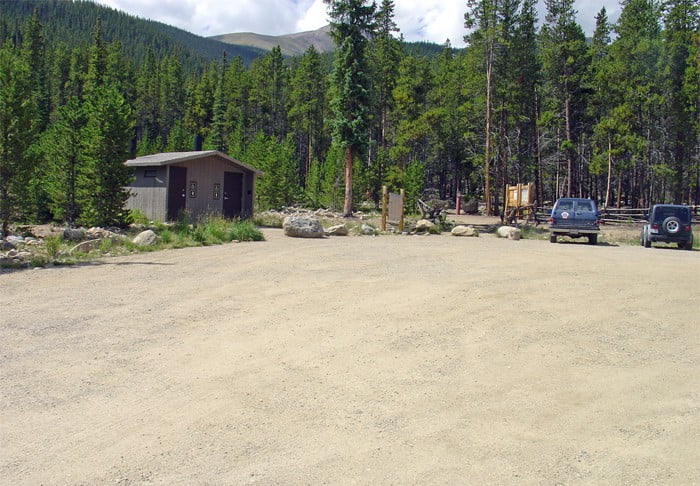
Not long after the start of the trail, you will see a split. Turn left. This will lead you on the North Mount Elbert Trail. Turning right will take you on the Continenal Divide Trail
Distance: 500 ft/ 150 m
Elevation: 10,050 ft/ 3,060 m
After 1 mile (1.6 kilometers), you will see another split. Stay on the right to continue on the North Mount Elbert Trail.
Distance: 1 mi/ 1.6 km
Elevation: 10,600 ft/ 3,231 m
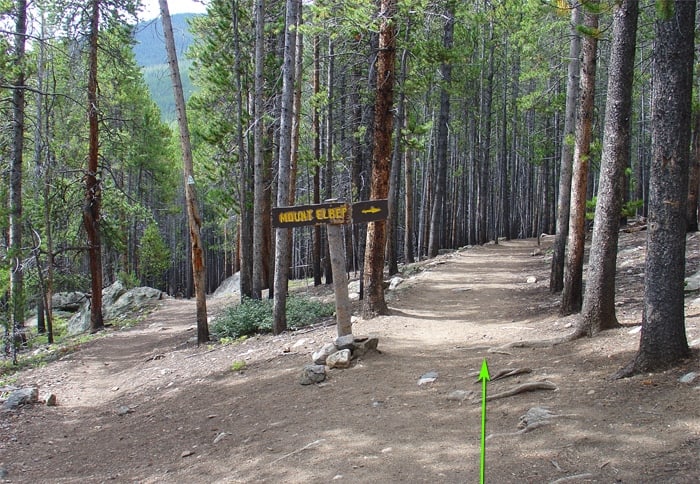
After another 1.7 miles (2.7 kilometers), you will break through the forested area. The trail is exposed from here to the summit.
Distance: 2.7 mi/ 4.3 km
Elevation: 12,000 ft/ 3,658 m
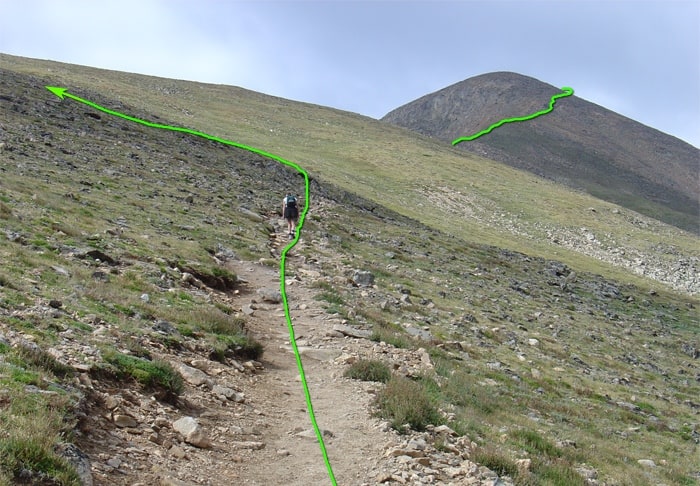
After another 2 miles, the trail becomes steeper. The trail remains steep for the next 0.3 miles (0.5 kilometers).
Distance: 3.7 mi/ 6 km
Elevation: 13,400 ft/ 4,080 m
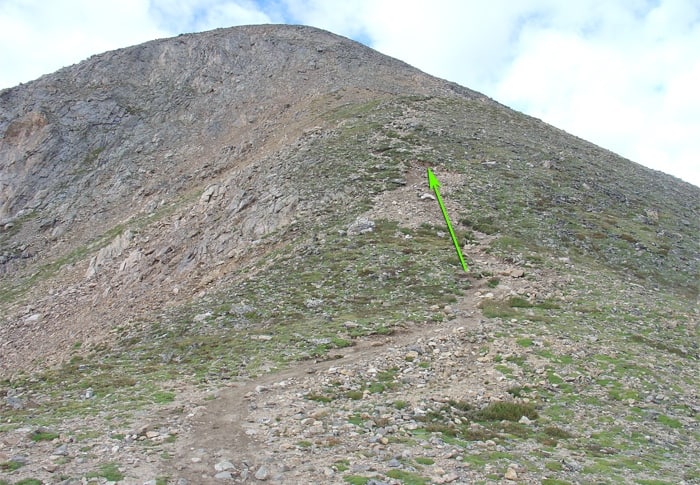
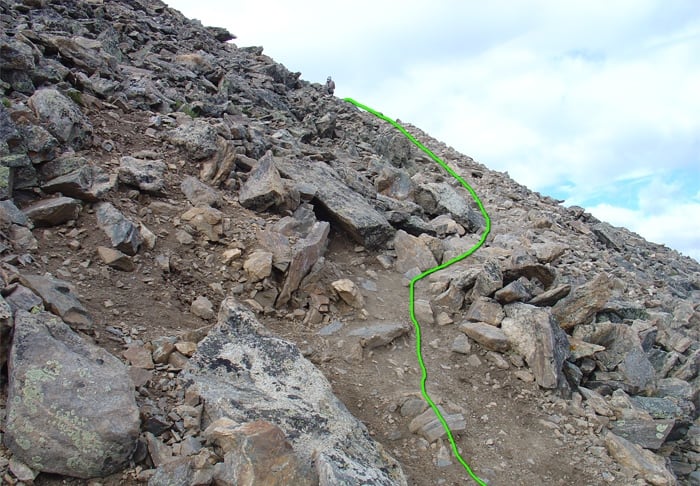
The trail flattens off here.
Distance: 4 mi/ 6.5 km
Elevation: 13,900 ft/ 4,240 m
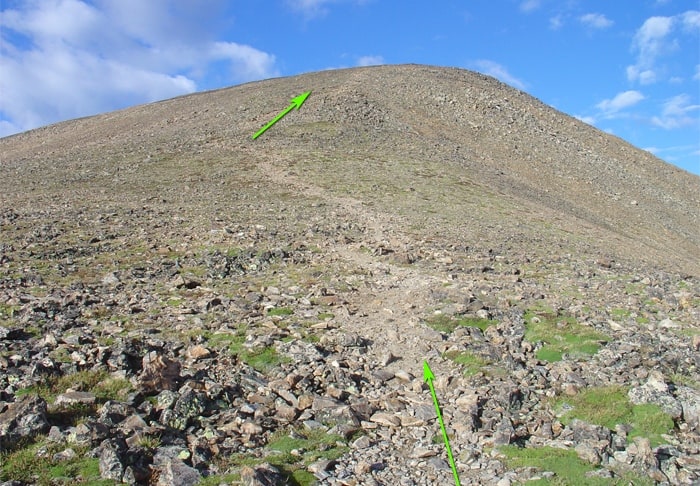
You can see the summit ridge from here.
Distance: 4.3 mi/ 7 km
Elevation: 14,300 ft/ 4,360 m
.

The summit!
Distance: 4.6 mi/ 7.4 km
Elevation: 14,400 ft/ 4,390 m

What To Expect On The South Trail
The following images are retrieved from 14ers.com. Full credits to them.
The South Trail is a loop. You take the same trail up and down.
The trail is well-maintained and you should not have a problem following the trail.
Forest Service Road 125B is a 1.8 miles (2.9 kilometers) dirt road that joins the South Lower Trailhead and South Upper Trailhead.
If you have a 4WD or a vehicle with high clearance, you can drive into the dirt road and start at the Upper Trailhead. Otherwise, you will hike along the dirt road from the Lower Trailhead.
South Lower Trailhead
Distance: 0 mi/ 0 km
Elevation: 9,600 ft/ 2,926 m
At the end of Forest Service Road 125B is the South Upper Trailhead. Cross the creek using the foot bridge to begin the trail.
Distance: 1.8 mi/ 2.9 km
Elevation: 10,440 ft/ 3,182m
After a short while, you will come across a split junction. Stay left to continue on the South Mount Elbert Trail.
Distance: 1,700 ft/ 500 m (from Upper Trailhead)
Elevation: 10,500 ft/ 3,210 m
After 3.2 miles, you start to leave the forest. The trail is mostly exposed from here to the summit.
Distance: 3.2 mi/ 5.1 km
Elevation: 11,400 ft/ 3,470 m
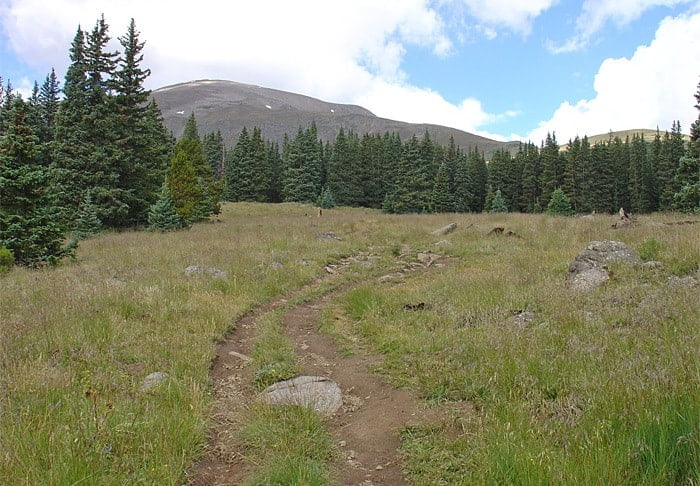
You can see most of the way to the summit. The rest of the way is fairly easy.
Distance: 4.8 mi/ 7.8 km
Elevation: 12,400 ft/ 3,780 m
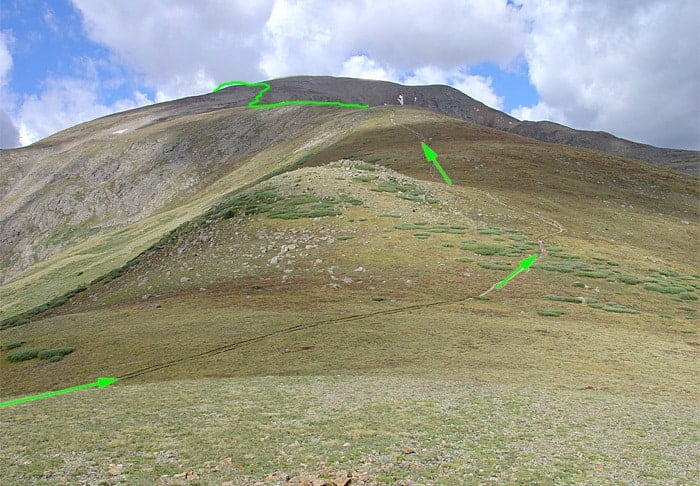

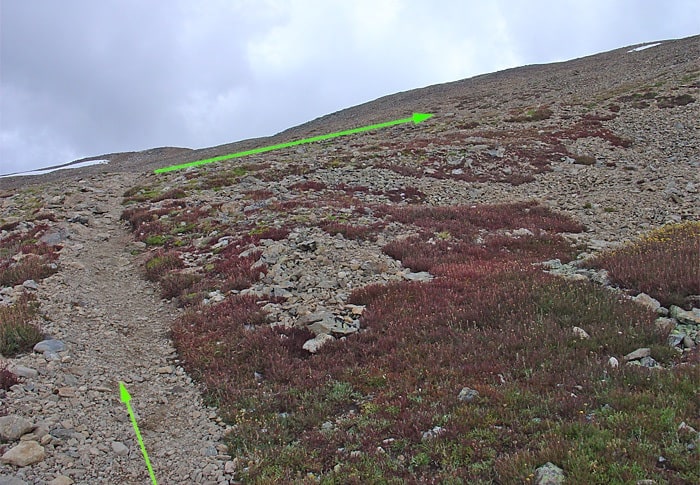
The summit!
Distance: 7 mi/ 11.3 km
Elevation: 14,400 ft/ 4,390 m
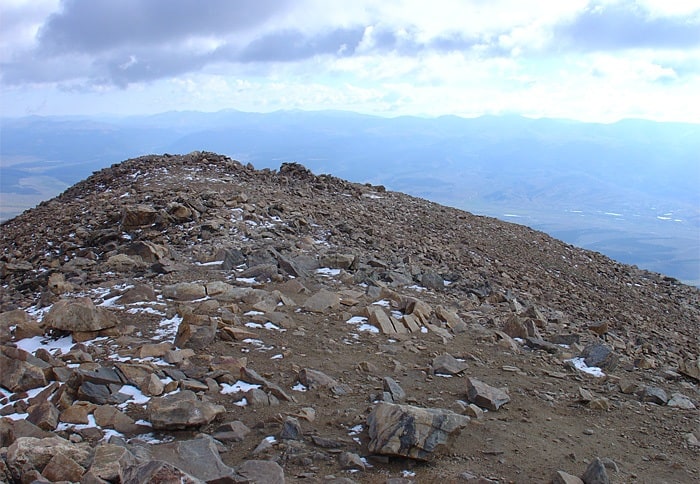
What Time Should You Start Climbing (Itineraries)
As mentioned earlier, afternoon thunderstorms are common when climbing Mount Elbert in summer. The storms can be quite violent. Other than the start of the trail through the forest, most of the North and South Trails are exposed. You won’t get any relief once the thunderstorm hits!
And because of that, most climbers will start off very early in the morning. You should target to reach the summit latest by 11 am. This will give you enough time to reach the forested areas before the thunderstorm hits.
Some climbers want to catch the sunrise on the summit. They will start off in the wee morning.
Another thing to consider will be the availability of parking. During the peak season for climbing Mount Elbert, the lots next to the trailheads start filling up by 6 am to 7 am.
If you are starting out later in the day, do take note of the sunset timings. Bring along your headlamp to avoid getting caught in the dark. The sunsets are quite late in the summer — about 8 pm to 8.30 pm. But keep track of your pace and the time you need to make the descent.
Here are some proposed itineraries:
Itinerary 1:
- To avoid the afternoon thunderstorms
- Assuming a 6 hour round trip
| 7.30 am | Begin climb |
| 10.30 am | Reach the summit |
| 11 am | Begin descent |
| 1 pm | Reach the forested area, thunderstorm starts |
| 2 pm | Return to the starting point |
Itinerary 2:
- To catch the sunrise
- Assuming a 6 hour round trip
| 2 am to 3 am | Begin climb |
| 5 am to 6 am | Reach the summit |
| June: 5.35 am to 5.45 am July: 5.40 am to 6.10 am Aug: 6.05 am to 6.45 am Sep: 6.35 am to 7 am | Sunrise |
| 6 am — 7.30 am | Begin descent |
| 9 am — 10.30 am | Return to the starting point |
| 1 pm | Thunderstorm starts |
Do You Need A Permit? Are There Any Fees?
For individual climbers or small groups, you don’t need to get a permit or pay any fees to climb.
If you are part of a commercial or organized group, you will need a permit. You have to apply for the permit through the Leadville Ranger District Office before your trip. There are no application forms online. You will need to call the ranger office at 1-719-486-0749 for more information.
What To Wear
Here’s what to wear for climbing Mount Elbert:
- Hat/ cap: You will be spending a lot of time directly under the sun with no trees for shelter.
- Sunglasses
- Inner layer
- Sweat-wicking shirt
- Trek pants or gym pants
- Insulating layer
- A jacket for keeping warm — can be fleece or down etc
- If you like to keep your leg warms, you can also consider bringing another layer
- Waterproof layer
- The weather is unpredictable in the mountains. Always pack a set of waterproof jacket and pants for your climb.
Find out how to choose the right layers for your climb here.
- Hiking socks
- Hiking boots: It is common to see people climbing with trail runners. But the trails are rocky and there might be snow or ice at some sections. I prefer to climb with my hiking boots. Check out my review of my favorite hiking boots here.
| Insider tips: – You won’t need your insulating or waterproof layers at the start of your climb. Pack them at the top of your backpack for easy access when you need them. Keep them in waterproof bags in case of rain. – Keep an extra set of clothes in your car. You can change out of your wet or sweaty clothes after your climb. |
If you are climbing outside of the June to September period, you will expect more snow in the mountains. Depending on the actual conditions, you will also need:
- Gaiters: These prevent snow or ice from getting into your boots.
- Snowshoes: You are likely to need snowshoes from the start of the trail to the top of the treeline. You may even need them all the way to the summit if the snow if soft or slushy.
- Crampons: These are usually not needed.
Packing List And What To Bring
Here’s what to bring for climbing Mount Elbert:
- Backpack: You will need a 25L to 30L backpack. Use a proper hiking backpack with a hip belt and padding on the shoulder straps. This will make your hike a much more comfortable one. You can see a review of my favorite 30L backpack here.
- Extra set of clothes (you can leave them in the car)
- Hiking stick: Useful when you are coming down from the summit. Helps with your balance and reduce the impact on your knees. Check out these tips on climbing with painful or injured knees.
- Headlamp: For climbing in the dark. Do not rely on a torchlight or your phone. You should keep your hands free during the climb.
- Water: Depending on your needs, I recommend at least 0.5 to 0.8 gallons (2 to 3 liters) of water.
- Food: Depending on the duration of your climb, you will need to pack some snacks or even a proper meal or two. Get some ideas on what food and snacks you can pack for your trip. You need to bring more food if you are climbing in winter.
- First aid supplies: I always have these items with me
- Plasters
- Eyedrops: In case sand or debris get into your eyes
- Medication for headaches, nausea, stomach upset, altitude sickness etc
- Insect repellent, ointments for insect bites
- Nail clippers: For some reason, my fingernails tend to chip or crack in the mountains
- Trash bags: There are no trash bins in the mountains. Everything that you carry in with you has to come out with you.
- Camera: You don’t want to be climbing to the top of Colorado and not have something to capture the amazing views! This is my favorite camera that’s easy to bring on a trail.
- Miscellaneous
- Sunblock
- Lip balm
- Tissue, napkins, toilet paper
- Hand sanitizer
- Whistle: Useful for an emergency, especially if you are climbing alone.
- Hand and foot warmers: Useful if you do not do well in cold temperatures.
If you are camping overnight, you will also need:
- Shelter: This can be a tent or bivy sack or tarp. Find out which is suitable for you here.
- Sleeping bag: Make sure it is sufficiently insulated for the weather.
- Sleeping aids: If you are a light sleeper, it helps to wear an eye mask or earplugs when you sleep.
- Bear canister: This is to keep food away from bears and other wildlife. You will need to hang the canister food from tree limbs 12 feet off the ground, 6 feet from the tree’s trunk, and 6 feet below the supporting limb.
- Pocketknife: Useful to cut ropes for hanging the bear canisters or for other camping needs.
For winter climbs, you will need:
- Ice axe: Ice axe is required when crossing snowfields. They are used to cut steps in hard snow or ice. They are also used for self-arrest (i.e. stopping your fall). Learn more about self-arrests and check out my favorite ice axe here.
- Avalanche safety gear such as snow shovel and snow probe.
| Insider tips: – To protect your stuff from the rain, pack them in small waterproof bags in your backpack. At a minimum, make sure you waterproof your electronics such as phones and cameras. I like to use ziplock bags for this. – Ziplock bags also double up as spill proof trash bags. These are perfect for storing food or other messy waste. |
How To Get To The Trailhead?
North Trailhead
There is a paved road leading up to the North Trailhead. This can be accessed by all cars.
You can check the latest update on the road conditions here.
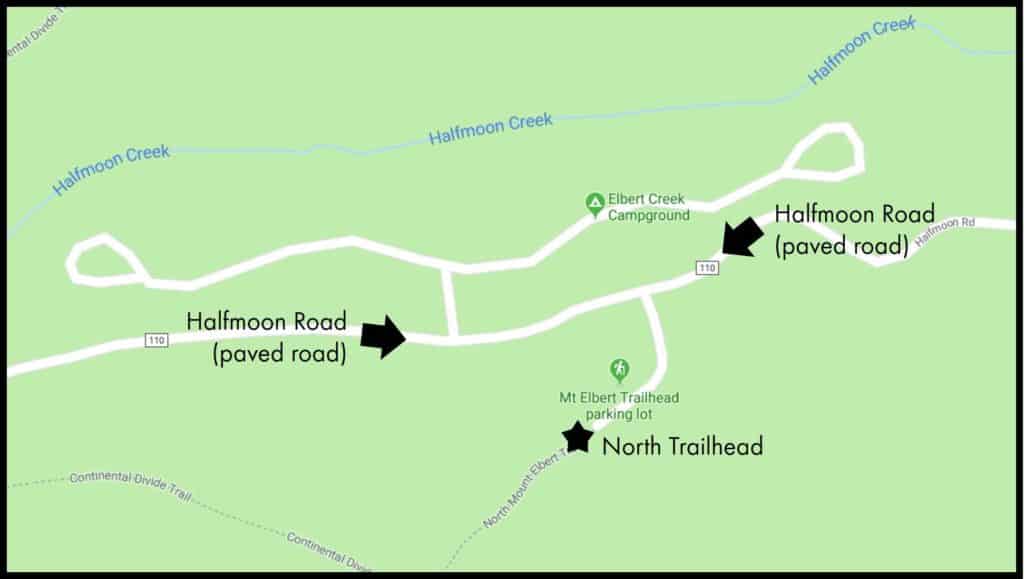
South Trailhead
South Lower Trailhead
There is a paved road leading up to the South Lower Trailhead. This can be accessed by all cars.
South Upper Trailhead
There is only a dirt road (Forest Service Road 125B) from the Lower South Trailhead to the Upper South Trailhead. You will need a 4WD or a vehicle with high clearance.
You can check the latest update on the road conditions here.

| Insider tips: – Afternoon showers might make the conditions on the dirt road a lot worse than when you arrived. – The dirt road Forest Service Road 125B is closed in the winter. |
Locations Of Parking Lots
There is free parking available next to the North and South trailheads.
| Insider tips: – The parking lots fill up by 6 am to 7 am during the busy periods. Get there early to secure a spot! – If you are using Google Maps or other navigation on your phone, download an offline map in case you lose cell reception. |
North Trailhead Parking
There are 2 parking options for the North Trailhead.
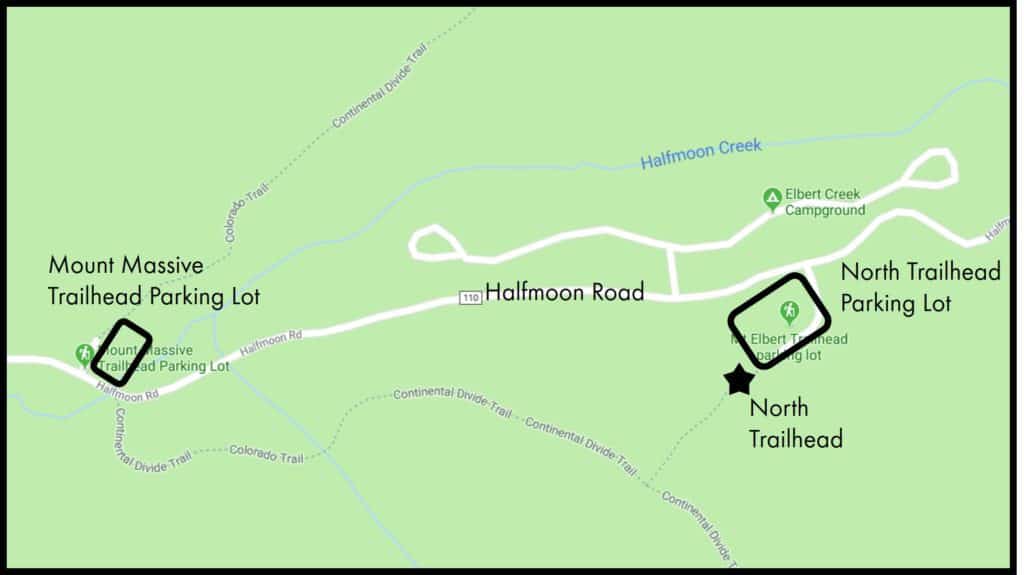
Depending on how the cars are parked, the parking lot can fit about 30 to 40 cars. The parking area also has a men’s and women’s bathrooms.
Parking lot location: Link to Google Maps
Coordinates:
39°09’07.3″N 106°24’43.8″W
39.152014, -106.412179
There’s also another parking lot about 2,000 feet (600 meters) away for the Mount Massive Trailhead.
Parking lot location: Link to Google Maps
Coordinates:
39°09’05.6″N 106°25’09.5″W
39.151549, -106.419310
South Trailhead Parking
There is one parking area at the South Lower Trailhead.
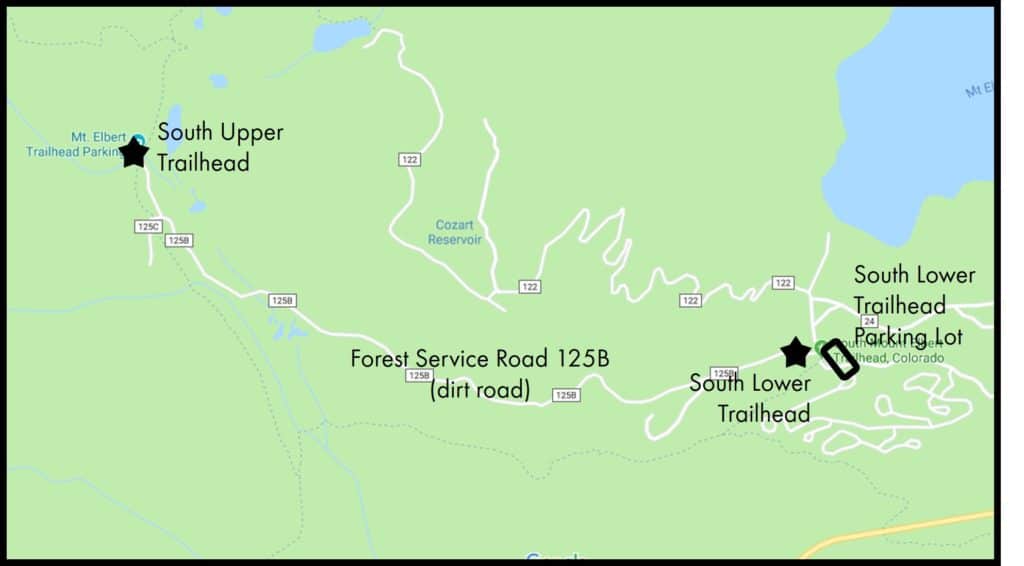
South Lower Trailhead Parking
This parking lot is about half the size of the one at the North Trailhead. It can probably park about 20 cars. There are no bathrooms here.
Parking lot location: Link to Google Maps
Coordinates:
39°05’56.9″N 106°22’01.3″W
39.099133, -106.367024
South Upper Trailhead Parking
If you have a 4WD, there is a dirt road Forest Service Road 125B next to the parking lot. You can drive up to the South Upper Trailhead about 2 miles (3.2 kilometers) away. There is no parking lot at the upper trailhead. You can just park along the dirt road. There are no bathrooms here.
Parking lot location: Link to Google Maps
Coordinates:
39°06’20.5″N 106°23’43.1″W
39.105706, -106.395303
Camping And Accomodation
Since you need to get an early start for climbing Mount Elbert, you may want to spend the night nearby.
Primitive camping is allowed in the forest. For your safety, avoid camping at parking lots or dirt roads. Climbers are driving in and out in the middle of the night with minimal lighting. Also, avoid camping next to the trailheads or along the trail which may be noisy.
Find out more about the restrictions and good practices here.
If primitive camping is not for you, there are developed campgrounds, RV campgrounds and cabins at several locations:
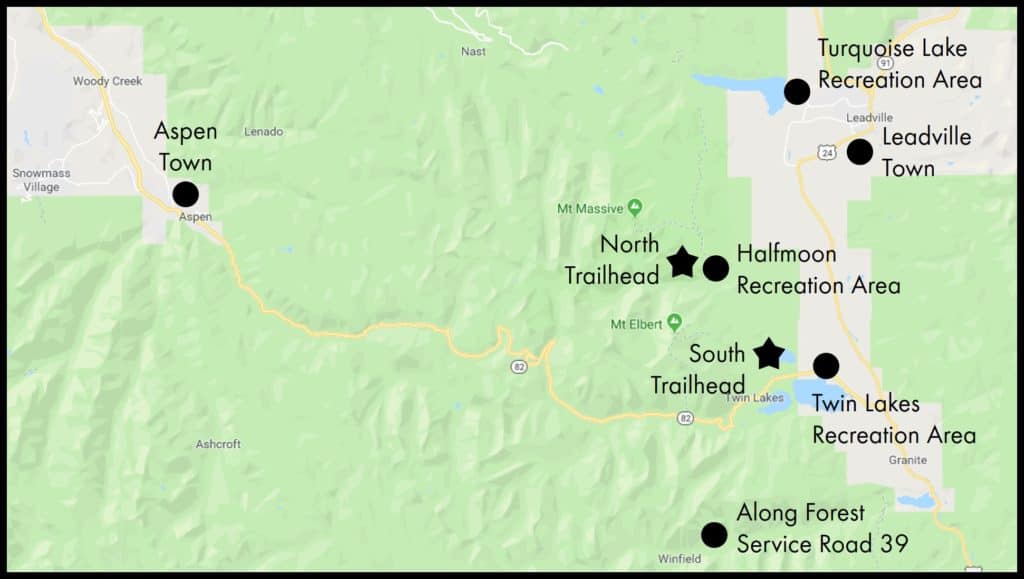
Halfmoon Recreation Area
This is next to the North Trailhead.
Campgrounds Reservations and Fees
RV Campgrounds Reservations and Fees
Twin Lakes Recreation Area
This is next to the South Lower Trailhead.
Campgrounds Reservations and Fee
RV Campgrounds Reservations and Fees
Turquoise Lake Recreation Area
This is to the north of Mount Elbert, on the west side of Leadville town.
Campgrounds Reservations and Fees
Group Campgrounds Reservations and Fees
RV Campgrounds Reservations and Fees
Along Forest Service Road 390
If camping is not for you, there are some cabins in this area. This is to the south of the Twin Lakes Recreation Area.
| Insider Tip: Most campgrounds are not opened throughout the year. Most of them are opened from May/ June to September/ November. |
Leadsville And Aspen Town
If you do not mind being further away from the trailheads, you can consider staying at Leadville or Aspen towns.
Climbing Mount Elbert In Winter: A Recap And Important Things to Note
- Avalanches are possible. Check the latest forecast here.
- Winter climbing is suited for more experienced climbers. If you are a beginner, make sure you climb with someone more experienced.
- The South Elbert Trail is the standard route for winter climbing. However, Forest Service Road 125B is closed in winter. You will need to hike the additional 1.8 miles (2.9 kilometers) each way from the South Lower Trailhead to the Upper Trailhead.
- You will need to wear additional insulating layers for your climb.
- You will need gaiters, snowshoes and even an ice axe. You may also need avalanche safety gear such as a snow shovel and snow probe. Learn how to use these pieces of equipment properly before your climb.
- You need to bring extra food.
- If you are camping, make sure your sleeping bag has sufficient insulation.
- The daylight hours are shorter in winter. Make sure you bring along your headlamps to avoid getting stuck in the dark.
- The trails may be hidden by the snow or ice. Make sure you are familiar with route finding (i.e. how to read a map and use a compass or GPS).
- There are a lot fewer climbers in winter. Do not expect to bump into other climbers if you are lost or need assistance.
What Are The Dangers Of Climbing Mount Elbert?
Although Mount Elbert is a relatively short and easy climb, there are still some dangers and risk involved.
Dehydration
Do not underestimate the amount of water you need. For a 5 to 7 hour climb, you will need at least 0.5 to 0.8 gallons (2 to 3 liters) of water.
Take a water break every hour. It is easier to stay hydrated by drinking frequently than to consume a huge amount at one go.
Altitude Sickness
The trailheads are at an elevation of 9,000 to 10,00 feet (2,750 to 3,050 meters). Altitude sickness can hit you at an elevation as low as 2,500 meters (8,000 feet). The lower oxygen at a higher altitude causes a lack of oxygen in your body.
Some common symptoms of altitude sickness:
- Headache
- Nausea
- Dizziness
- Shortness of breath
- Loss of appetite
- Difficulty sleeping
- A general loss of energy
Mild forms of altitude sickness can go away as you get used to the altitude.
How to prevent altitude sickness
- If you are coming from a low lying area, spend at least a few hours at the higher altitude before climbing. Arrive one day before your climb. Spend an afternoon or evening in town or at the campsites to acclimatize to the altitude.
- Avoid climbing too fast. The faster you go, the more your body struggles to maintain its oxygen levels. Go at a decent pace and take frequent breaks.
What to do if you get altitude sickness
- Stop and rest for at least half an hour.
- Once you are rested, go at a slow pace.
- If the symptoms do not go away or are getting worse, descent immediately. Severe altitude sickness can be life-threatening. Seek medical attention if necessary.
Read more about altitude sickness here.
Hypothermia
Even in the summer, expect cold temperatures at the summit. At the hottest, expect 40 F to 60 F (5 C to 15 C). At the coldest, expect 14 F to 30 F (-10 C to 0 C).
You can check the latest forecast here.
The temperature can drop drastically from the trailhead to the summit. Don’t think you can start off your climb in a shirt and shorts and make it to the top without any additional layers. Since there are no trees at the higher zones, you are exposed to strong winds continuously.
And if you are caught in the afternoon thunderstorms, hypothermia becomes a serious risk.
How to prevent hypothermia:
- Bring sufficient layers to deal with the coldest temperature expected during your climb. It will be the coldest at night and at the summit.
- Bring a waterproof jacket and pants for wet weather.
- Start your climbs early to avoid the afternoon thunderstorms. Check the latest weather forecast.
What to do if you get hypothermia
- Get out of the cold as quickly as possible.
- Dry yourself.
- Put on as many layers as you can to warm yourself up.
- Drink hot beverages or eat hot food.
- Hypothermia can be very serious, seek medical attention if necessary.
Losing Your Way
The North and South Trails are well-maintained trails with high traffic. You should not get lost if you stay on the trail and do not take any shortcuts.
Getting lost is a bigger risk at night and in winter. Heavy snow could cover the trails and make it difficult to know where you are going.
How to avoid getting lost:
- If you are traveling in a group, partner up. Always let your partner know if you are stopping for a break or taking a leak in the woods.
- If you are climbing solo, bring a whistle or wear a bright shirt to attract attention in case of emergencies. Inform someone of your expected time of return so that they can get help in case they do not hear from you.
- If you are climbing in the dark, always wear a headlamp!
- Only climb in winter if you are familiar with route finding.
Other Important Information
- There is no potable water at the trailheads or along the trail. There is a creek near the South Upper Trailhead. You will need to treat the water before drinking. The easiest way is to use water purifying tablets. Learn more about them here.
- Dogs are allowed on the trails. They are supposed to be kept leashed but you may see many unleashed dogs.
This is Part 2 of 6 of the Mountains To Climb In The US Mini-series:
Part 1: Highest Mountains To Climb In The US For Beginners
Part 2: Ultimate Guide To Climbing Mount Elbert
Part 3: Ultimate Guide To Climbing Mount Katahdin
Part 4: Ultimate Guide To Climbing Mount Bierstadt
Part 5: Ultimate Guide To Climbing South Sister
Part 6: Ultimate Guide To Climbing Mount Borah
Save to Pinterest and add this to your bucket list!

